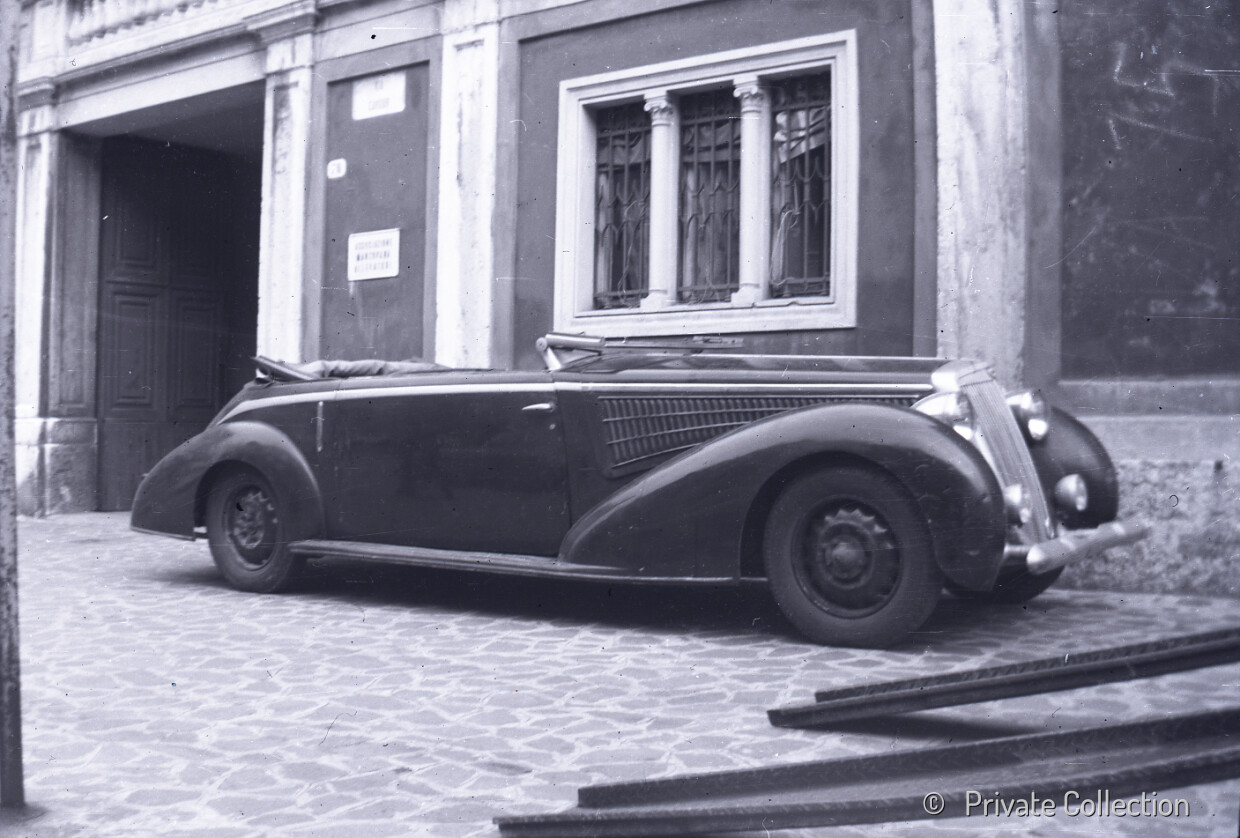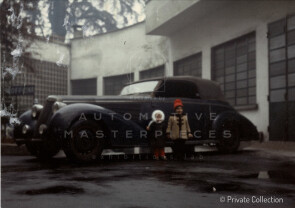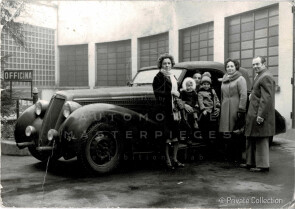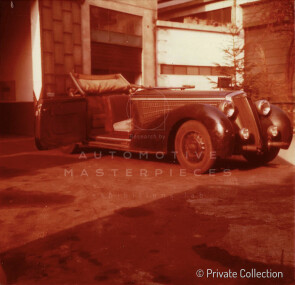
1938 Lancia Astura 4a serie Cabriolet
ON/OFF
Why am I an Automotive Masterpiece?
L. Limited edition cars
no. 41 manufactured, 11th built
The Lancia Astura was a car produced by the Turin-based company from 1931 to 1939. In the early 1930s, Lancia’s latest model was the large Dilambda (launched in 1929), while the Lambda—after nearly a decade in production—was due to be replaced. The Dilambda featured a V8 engine with a 4-liter displacement, whereas the Lambda, originally equipped with a 2.1-liter engine, reached over 2.5 liters in its final series. Although the Dilambda retained its flagship status, Lancia decided to replace the Lambda with two new models aimed at different customers: the Artena, a 4-cylinder car with a displacement under 2 liters, and the Astura, fitted with a 2.6-liter V8 engine. The two models were mainly differentiated by their engines but also had different wheelbases: the Artena had a 299 cm wheelbase, while the Astura’s was 19 cm longer to accommodate the larger engine. Unlike previous Lancia models, the Astura was named after a historic castle near the Roman city of Nettuno. Its V8 engine, with a 19° angle between banks, was a simplified and downsized version of the Dilambda unit, with a displacement of 2606 cc and an output of 72 hp at 4000 rpm. In addition to a cast-iron engine block, triple chain-driven distribution, and a self-cleaning oil filter, the engine’s most distinctive feature was its unique two-piece cylinder head: the lower part (cast iron) housed the valves, while the upper part (aluminum) contained the rocker arms and their shaft, with the central camshaft rotating between the two. The water-based cooling system, derived from the Artena, included a thermostat-controlled throttling device. The Astura also shared the centralized lubrication system with the Artena. Moving away from the unitary body construction of the Lambda, both the Astura and the Artena employed a chassis made of two vertical box-section side members reinforced by an X-shaped brace. Two longitudinal round tubes branched from a central cross-member and were integrated into the front ends of the side members, which slightly converged. The suspension system combined different solutions: at the front, Lancia’s classic layout was retained—though without the diagonal braces that, in the Lambda, had connected the radiator frame to the suspension cylinders, now made redundant by improved chassis rigidity—while the rear used a conventional live axle with semi-elliptical leaf springs and Siata friction shock absorbers. Powered by a Zenith double-barrel carburetor, the Astura offered excellent performance thanks to its favorable power-to-weight ratio. The chassis weighed just under a ton (960 kg), and even the sedan version remained relatively light at 1,250 kilograms, enabling a top speed of around 125 km/h. While Lancia did produce a sedan version—available with either four windows and 4–5 seats or six windows and 6–7 seats—the Astura became the queen of custom coachbuilt cars of its era. Nearly all major Italian coachbuilders, as well as several international ones, created special-bodied examples. Notable names included Bertone, Boneschi, Borsani, Brianza, Castagna, Colli, Garavini, Ghia, Stabilimenti Farina, Touring, and Viotti, along with international firms such as Weinberger & Buhne, John Charles, Abbott, and Kevill Davies & March. A cabriolet by Pinin Farina, built in 1936, was awarded Best of Show at the Pebble Beach Concours d’Elegance in 2016. Another cabriolet by Stabilimenti Farina won the 1947 edition of the Concorso d’Eleganza Villa d’Este, although it never entered mass production. First introduced at the Paris Motor Show in October 1931, the Astura underwent a minor update about a year later (Second Series). In 1933, with the Third Series, more significant changes were introduced: the chassis was made available in two different wheelbase lengths, the engine displacement was increased (from 2.6 to 3 liters), power was improved by about 10 hp, and the braking system was revised. Further significant changes were made to the chassis in 1937 with the Fourth Series, which effectively replaced the discontinued Dilambda. Chassis from this series were often used for official government vehicles, mostly designed by Boneschi and Pinin Farina, sometimes with monumental proportions. The engine of the final Astura series also served as the basis for the Lince armored car, occasionally referred to as the “Astura armored car.” A total of 2,912 Astura units were produced.
Launched in 1937, the fourth and final series of the Astura introduced further refinements, while repositioning the model toward a more institutional and formal role. The chassis retained the two available wheelbase lengths, but featured additional structural reinforcements to meet the needs of coachbuilders tasked with creating official vehicles. Most examples of this series were bodied as limousines, landaulets, or formal sedans by renowned ateliers such as Pinin Farina and Boneschi, often distinguished by imposing and monumental proportions. Mechanically, the engine remained the 3-liter V8 introduced with the third series, though minor adjustments were made to improve reliability and torque delivery. Thanks to its combination of power, refinement, and versatility for coachbuilding, the Astura Series IV became the favored base for state ceremonies, diplomatic duties, and military staff cars. A number of these vehicles, especially those with long-wheelbase chassis, were later preserved in museum collections or continued to be used into the early postwar years.
The Lancia Astura chassis no. 41-3062 is a two-door convertible with a Boneschi body. The factory records precisely indicate the assembly dates of the various parts, and the car was completed on April 30, 1938. A total of 423 Astura 4a Serie have been built from 1937 to 1939; 284 only in 1938. Chassis no. 41-3062 was delivered to the Minetti agency, one of the largest Lancia agencies and certainly the main one for Boneschi bodyworks, which had its customer base primarily in Lombardy and the northeast. The car is one of the 82 Astura, and one of the 41 Astura “Tipo 41” produced that were bodied by Boneschi, and is one of the just 10 convertibles (considering all variables, even "Ministerial" cars). But, in the end, chassis no. 41-3062 is very likely a one-off. The soft top had an extraordinary feature for 1938: it moved thanks to an electric mechanism. The car had another peculiarity for this model: it was used primarily as a private car and not for public functions, such as parades. It was registered in Milan (MI 69044) only a year later, on May 3, 1939. Minetti delivered the vehicle on May 4, 1939, to its first owner, Italo Lattuada. He, a wealthy man, had the car customized: being very short, unlike his much taller wife, the seats were aligned so that they were both at the same height. Lattuada kept it through the difficult years of the war, and, in April 1950, he sold it to… himself, by registering the car to his own “Società Italiana Noleggio Tassametri”. This company managed the rental of taximeters for public cars throughout Italy, thus proving to be a profitable source of income for Lattuada. The car was in his possession for his whole life, and sold only after his passing, by his widow. Chassis no. 41-3062 was purchased at the end of 1974 by the well-known collector Edoardo Tenconi, who rented it the following year, along with three other vehicles, for the filming of Pierpaolo Pasolini's movie Salò o le 120 giornate di Sodoma, although the car was mostly used as transportation. After filming, the Astura temporarily remained near Bologna and narrowly escaped destruction on April 15, 1978, during the catastrophic train accident in Murazze di Vado, being only a few dozen meters away from the derailed trains. In the meantime, the car received its first ASI certification and was subsequently listed in the Registro Storico Lancia. In the 1990s, parts of the vehicle, which were under restoration, were stored in a warehouse that caught fire; the rear seats and other parts were partially damaged. In 2023, the car became part of a private collection. Today, the car's heritage includes a considerable amount of all kind of papers that document its history in all its stages. Exceptional condition for a pre-war car, the car has: original plates and booklet; invoices for all work carried out; letters, including an endorsement to proceed from Gianni Lancia himself. Now in a private collection, the car is undergoing a thorough restoration.




